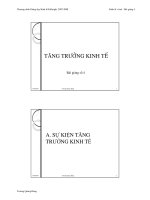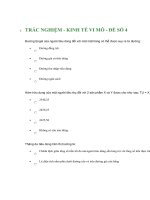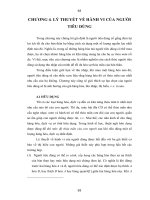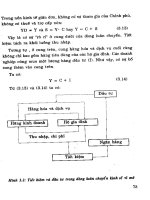KINH TẾ VI MÔ 2015 chapter 4 microeconomics producers choice
Bạn đang xem bản rút gọn của tài liệu. Xem và tải ngay bản đầy đủ của tài liệu tại đây (833.57 KB, 10 trang )
Contents
1.
Chapter 5
2.
MICROECONOMICS
3.
Theories of Producer
Behavior
The Production Theory
The Production Cost Theory
The Profit Theory
By Tran ThiKieu Minh, MSc.
2015, FTU Kieu Minh
1
2
5.1.1 Production Technology
Chapter 5
◦ Inputs: land, labor, capital & raw materials
◦ Outputs: cars, desks, books, etc.
5.1.THE PRODUCTION
THEORY
Basic Microeconomics
Describe how inputs can be transformed
into outputs
3
Firms can produce different amounts of
outputs using different combinations of
inputs
4
Short- run and Long-run
Production Function
We can represent the firm’s
production technology in form
of a production function
Production Function:
Short Run
◦ Period of time in which quantities of one or more
production factors cannot be changed.
◦ These inputs are called fixed inputs.
◦ Short-run Production Function:
Q = F(L) or Q = f(K)
◦ Indicates the highest output (Q) that
a firm can produce for every
specified combination of inputs.
◦ Shows what is technically feasible
when the firm operates efficiently
◦ For simplicity, we will consider only
labor (L) and capital (K)
Long-run
◦ Amount of time needed to make all production
inputs variable.
◦ Long-run Production Function: Q = F(K, L)
◦ The production function is true
for a given technology
Q = F(K,L)
Short run and long run are not time specific
5
6
Returns to Scale
Returns to Scale
How does a firm decide, in the long run,
the best way to increase output
Rate at which output increases as inputs are
increased proportionately
Production technology:Q = f (K,L)
◦ Can change the scale of production by
increasing all inputs in proportion
◦ If double inputs, output will most likely
increase but by how much?
◦ Increasing returns to scale:
F (mK,mL) > mQ (m > 1)
◦ Constant returns to scale:
F (mK,mL) = mQ, (m > 1)
◦ Decreasing returns to scale:
F (mK,mL) < mQ (m > 1)
7
8
Quiz
5.1.2 Production in the Short-run
How is the return to scale of the following
production technologies?
with One Variable Input
We assume capital (K) is fixed and labor
(L) is variable
a.
Q b.K 0.7 .L0.6
◦ Output can only be increased by increasing
labor
◦ Must know how output changes as the
amount of labor is changed (Table 6.1)
Q c.3K 5L
Q d.2 K L
Q K L2
10
Total Product
Example
Output
D
112
C
60
B
Total Product
At point D, output is
maximized at 112 units
A
0 1 2 3 4 5 6 7 8 9 10 Labor per Month
11
12
Product Curves
Average product of Labor
Output per unit of a particular product
Measures the productivity of a firm’s labor in
terms of how much, on average, each worker
can produce
AP is slope of line from
origin to point on TP
curve
q
q/L
112
60
AP
30
C
Output
Q
Labor Input L
20
B
10
0 1 2 3 4 5 6 7 8 9 10
0 1 2 3 4 5 6 7 8 9 10
Labor
Labor
13
14
Product Curves
Marginal Product of Labor
Additional output produced when labor
increases by one unit
Change in output divided by the change in
labor
MP is slope of line tangent to
corresponding point on TP
curve
q
q
D
112
30
60
Output
Q
MPL
Labor Input L
30
15
10
A
0 1 2 3 4 5 6 7 8 9 10
Labor
15
0 1 2 3 4 5 6 7 8 9 10
Labor
16
Marginal & Average Product
Law of Diminishing Marginal Returns
MPL APL APL
Law of Diminishing Marginal
Returns: As the use of an input
increases with other inputs fixed, the
resulting additions to output will
eventually decrease.
MPL APL APL max
◦ As we increase labor the additional output
produced MPL declines
MPL APL APL
MPL 0 Q max
17
18
Quiz:
Short-run Production technology of a firm
can be shown as:
3
L
10
What are the function of MPL, APL
Q 10 L L2
a.
b.
c.
d.
How much is the maximum quantity of this
firm? How much labor are used then?
At which level can the law of diminishing
return of labor be seen
At which level is the average product of
labor maximum?
19
5.2.THE PRODUCTION COST
THEORY
20
Economic Cost
5.2.1 Which Costs Matter?
Accountants tend to take a retrospective
view of firms costs, where as economists
tend to take a forward-looking view
Accounting Cost = AC
◦ EC = AC +OC
◦ Actual expenses plus depreciation charges for
capital equipment
Economic costs distinguish between costs the
firm can control and those it cannot
Economic Cost = EC
◦ Cost to a firm of utilizing economic resources
in production, including opportunity cost
Opportunity cost (of firm’s resources)
◦ Cost associated with opportunities that are
foregone when a firm’s resources are not put to
their highest-value use.
21
22
Sunk Cost
5.2.2 Costs vary with Output
Expenditure that has been made and
cannot be recovered
Should not influence a firm’s future
economic decisions.
Firm buys a piece of equipment that
cannot be converted to another use
1.
Fixed Cost - FC
◦ Does not vary with the level of output
2.
Variable Cost - VC
◦ Cost that varies as output varies
3.
◦ Has no alternative use so cost cannot be
recovered – opportunity cost is zero
◦ Decision to buy the equipment might have
been good or bad, but now does not matter
Total Cost - TC
TC FC VC
23
24
Average Costs
Marginal Cost (MC):
◦ The cost of expanding output by one unit.
◦ Fixed cost have no impact on marginal cost,
so it can be written as:
Average Total Cost (ATC)
◦ Cost per unit of output
◦ Also equals average fixed cost (AFC) plus
average variable cost (AVC).
MC
TC
AFC AVC
q
TC TFC TVC
ATC
q
q
q
ATC
ΔVC ΔTC
Δq
Δq
25
Quiz: fill in blanks
Q
AFC
VC
ATC
Graph
MC
0
30
50
C
TC
10
VC
20
40
TC = FC + VC
TC
100
10
26
11
420
390
C*
FC
Q
16
Graph: Average Cost
Marginal Cost - MC
C
◦ Average Fixed Cost: AFC = FC / Q
◦ Average Variable Cost:AVC = VC / Q
◦ Average Total cost:ATC= TC / Q
ATC = AFC + AVC
MC
A TC
AVC
A TC
C
Q
AVC
When MC is below AVC, AVC is falling
When MC is above AVC, AVC is rising
When MC is below ATC, ATC is falling
When MC is above ATC, ATC is rising
Therefore, MC crosses AVC and ATC at the minimums
A FC
Q
30
5.3.1 Revenue
Revenue (R) /Total Revenue (TR)
◦ TR = P x Q
Chapter 5
◦ Revenue is curved showing that a firm can only sell more if it
lowers its price
5.3.THE PROFIT
THEORY
Average Revenue
◦ AR = TR/Q
◦
31
TR
TRQ'
Q
Slope in revenue curve is the marginal revenue (MR)
Marginal Revenue MR
32
Revenue Maximizing
Cost,
Revenue,
Profit
($s per
year)
5.3.2 Profit
TRmax TR ' 0 MR 0
Profit for the firm, , is difference between
revenue and costs
(q) R(q) C(q)
B
A
0
R(q)
◦ Profit () = Total Revenue - Total Cost
◦ Total revenue (TR) = R (q) = P x q
◦ Total Cost (TC) = C (q)
MR
Q0
Output
Accounting Profit
Economic Profit
34
34
33
Variables affecting to Profit
TR TC P Q ATC Q ( P ATC ) Q
Market Price (P)
ATC
◦ Return to Scale
Quantity - Q.
◦ Depend of demand of the products
Profit Maximization
Profit is maximized at the point at which an
additional increment to output leaves profit
unchanged
TR TC
TR TC
0
q
q
q
MR MC 0
MR MC
36
Profit Maximization
Cost,
Revenue,
Profit
($s per
year)
Quiz
Profits are maximized where MR
(slope at A) and MC (slope at B)
are equal
A
C(q
)
A firm faces a demand curve of their goods and knows
their production cost as:
P 12 0.4Q
Profits are
maximized
where
R(q) –
C(q) is
maximized
TC 0.6Q 2 4Q 5
R(q
)
B
a.
b.
0
q0
q*
c.
Output
(q)
max ' 0 MR MC
37
Quiz 2
Kurt Vile produces and distributes the Libertarian
Magazine, "Anarchy." Demand is given by
P = 55 - 2Q.
His cost function is TC = 100 - 5Q + Q 2
a. What is Kurt’s marginal revenue as a function of Q?
b. If Kurt wants to maximize profits, what price does he
charge? How much profit and consumer surplus is
generated at this price?
c. If Kurt wants to maximize total social surplus what
price does he charge? What are his profits at this
price?
d. What is the deadweight loss if profits are maximized?
2015, FTU Kieu Minh
39
How much is the optimum quantity, selling price,
revenue and profit of this firm
In order to maximizing profit?
In order to maximizing revenue?
In order to maximizing revenue as subject to profit is
10 ?









